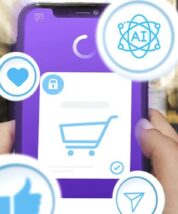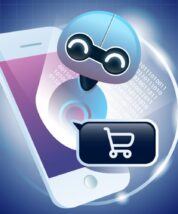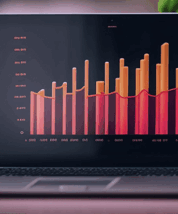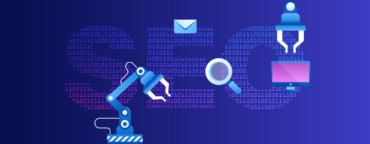Introduction
In this article, you’ll discover the best online sales techniques on how to boost e-commerce sales and conversions.
1.1.The importance of e-commerce in today's economy :
It's a fact that since the health crisis, online sales have exploded. In the first quarter of 2024, the FEVAD (Fédération du e-commerce et de la vente à distance) revealed that Internet sales were up 7.5% on the previous year. Sales reached 42.2 billion euros, up 7.5% year-on-year. Between 2019 and 2023, sales of online products rose by 34%. In 2024, e-tourism generated a total of around 625 million transactions, representing growth of 9.3% on 2023. In 2020, this sector was hit hard, with sales down 49%.
1.1. Why is it advisable to have an online store for your business?
Consumers like to have choices. Even if they can visit a physical store, they want the option of finding the same items online to make a purchase. In fact, many consumers prefer this option to visiting a retail outlet. It is therefore essential for your company to set up an online store and develop an e-commerce marketing strategy so as not to miss out on numerous sales opportunities. What's more, it gives a wider range of consumers access to your products and enables you to close sales with people outside your local area.
Setting up an e-commerce store is easier than it sounds. With platforms like Shopify, you can easily set up your own online store and list your products on well-established platforms like Amazon or eBay, which generate substantial traffic. By reaching a larger number of customers and allowing people to buy your products 24/7, you'll be able to quickly boost online sales and increase your revenues.
2.2. Reasons why you can't increase your e-commerce sales
You're targeting the wrong audience:
One of the main reasons why your store isn't generating good online sales is that you may be targeting the wrong market. It's not enough to know how to market a product: it's crucial to know exactly who to offer it to.
Many companies broadcast their campaigns to an unqualified audience, wasting time and marketing budget. To avoid this, a strategic, data-driven approach is essential:
- Data-driven personas built from advanced analytics to better understand your ideal customers.
- Real-time behavioral segmentation to adapt messages according to users' actions and intentions.
- Use of AI for predictive targeting, enabling you to anticipate consumer needs even before they are expressed.
- Cross-platform retargeting strategies, ensuring a consistent and effective presence across all relevant channels.
Before entering a potential market, carry out in-depth research and align your offer with the specific expectations of your target audience. A thorough understanding of your audience is the key to profitable and sustainable e-commerce.
2.1. You haven't defined your sales funnel properly
Another common cause of poor e-commerce performance is a poorly structured sales funnel. If your visitors don't quickly find what they're looking for, they'll leave your site without making a purchase.
Today's shopping journeys are omnichannel, complex and non-linear. It is therefore essential to align your funnel with these new realities, by integrating modern approaches such as :
- Intelligent omnichannel journeys, ensuring a seamless experience between mobile, desktop, social networks and physical points of sale.
- Leveraging micro-moments and intent marketing to capture attention at the right time with the right message.
- Multi-touch attribution to understand the impact of each touchpoint in the conversion process.
- Integration of chatbots and conversational AI, directing users in real time to the right products and enhancing the customer experience.
A well-designed funnel doesn't just accompany the user: it anticipates their needs at every stage of the journey and maximizes the chances of conversion.
2.3. A typical user journey is as follows
- The visitor sees an advertisement or searches for a product on a search engine
- Visits your website to find relevant products
- They search for the product on the website, then check its price
- They like the product and place an order
If the visitor can't find the product on the page, he won't take another step. Instead, he'll probably click on the “back” button and go to another website, increasing the bounce rate and lowering the ranking.
2.4. Your website is difficult to navigate
Pay particular attention to the user journey on your website. Research suggests that shoppers are likely to pay more if they experience a seamless user journey on an online store. According to a survey conducted by Sweor, 57% of Internet users believe they would not recommend a company with a poorly designed website.
2.5. Delays in shipping orders are significant
One of the reasons why your online sales are not increasing is that shipping times are considerably longer. Most people want to receive their products within a day or two. Amazon, for example, offers Prime shipping, which allows consumers to receive their orders usually in just one day.
Be sure to clearly mention all shipping details on the checkout page and on the product description page, so that customers know when they can expect to receive the desired product.
Would you like to develop a high-performance e-commerce site to increase your online sales and achieve your business goals?
3.3. What sources of traffic for your online store?
3.1. Referral traffic:
Referral traffic is anyone who comes to your site via a link from another website, whether on a blog post or in a news article. These links can be a valuable source of traffic if they are placed on authoritative sites.
3.2 Email marketing
E-mailing campaigns that link back to your site are an important source of traffic. Every time one of your customers clicks on one of your newsletters or on a marketing e-mail you send them, traffic to your site increases.
3.3. Paid advertising :
Paid advertising, also known as “pay-per-click” (PPC), is a simple and inexpensive way to drive traffic to your site. Basically, the advertiser pays a predefined amount every time a user clicks on one of their ads. It's a fast way to bring genuinely interested people to your website.
3.4. Social networks:
Social networks are an important traffic acquisition channel. In fact, they're ideal for reaching new people who are similar to your current audience. Social networks allow you to connect and engage with people who can generate huge amounts of free traffic. If you put in enough effort, the results can be fabulous over the medium and long term.
3.5. TikTok and Instagram Shopping
These social platforms enable brands to showcase their products directly in users' news feeds. Thanks to integrated shopping functionalities, they are transformed into ultra-visual, interactive e-commerce showcases - ideal for capturing a young, connected and engaged audience.
3.6. Influencer marketing and user-generated content (UGC)
Collaborating with influencers or promoting content created by your own customers is an excellent way of attracting qualified traffic. These approaches build trust in your brand and stimulate organic engagement around your products.
3.7. Organic traffic (SEO)
All Internet users who arrive on your site after performing a search on Google or another search engine are part of your organic traffic. To increase this, it's essential to work on your SEO with a well-optimized site (UX and CX) and quality content, designed to meet your visitors' expectations.
3.8. Voice search and visual search
With the rise of voice assistants and image search, these new channels are becoming strategic levers for attracting high-intent traffic. Adapting your content to these uses will keep you one step ahead.
3.9. Emerging marketplaces
In addition to major platforms such as Amazon, many more specialized or local marketplaces are emerging. They offer great opportunities for targeted visibility, and can generate interesting additional traffic.
3.10. Podcasts and audio marketing
Audio content is gaining ground! Participating in podcasts or broadcasting advertising messages in this format enables you to reach an attentive, often highly engaged audience. It's also an excellent way of redirecting this audience to your website.
4.What techniques can you use to boost your e-commerce sales?
4.1 Optimize your site to incite action:
Optimizing a website is all about boosting e-commerce. It encompasses many strategies and tactics that can help a company convert more visitors into customers, including the following:
- Write compelling and interesting product descriptions: Texts can entice consumers to buy by appealing to certain psychological processes. For example, by emphasizing feelings of reciprocity or exclusivity; or by creating a sense of urgency with a limited offer.
- Add images that highlight products. Visual elements are very important in marketing, especially for consumers who can't see or touch a product before making an online purchase. To offer them more information, static images can be supplemented with photos of models using the product and videos offering a 360-degree view.
4.2 Create an optimal customer experience
Customer experience is one of the key differentiating factors in finalizing a sale, ahead of price or product positioning. So it's important for a brand to create a seamless customer experience at every level.
To achieve this, we recommend :
- Add a FAQ. Providing answers to frequently asked questions on your e-commerce site helps potential customers easily and quickly find the information they're looking for before making a purchase.
- Optimize page load times. If it takes more than 3 seconds to load your pages, visitors will leave your site and probably never return. Therefore, you can make adjustments to improve loading speed such as reducing image size, choosing your hosting carefully, compressing and cleaning up site code, etc.
- Include user-generated content (reviews, images posted on social networks, testimonials). This will show potential customers that you interact with your customers, enhancing their overall buying experience.
4.3. Choose the best online payment solution:
Payment security is a fundamental aspect of any online store. Whether it's solutions offered by banks or 100% digital services such as PayPal, Google Pay - which benefits from the credibility of the Google ecosystem - or Stripe, recognized for its reliability and ease of integration, it's essential to offer secure and reassuring payment methods for your customers.
Today, the shopping experience is enriched by new e-commerce solutions and strategies that meet the expectations of an increasingly connected public. Payment in instalments, or “Buy Now Pay Later (BNPL)”, is becoming increasingly popular.
It enables consumers to spread out their payments, often at no extra cost, making decisions easier and improving conversion rates. Cryptocurrencies and digital wallets, meanwhile, offer modern, flexible alternatives, particularly suited to technophile or international customers. Payment by biometric recognition - via fingerprint or facial recognition - is also developing, providing an additional layer of security while simplifying the user experience, particularly on mobile.
Finally, integrated solutions such as Apple Pay or Google Wallet enable customers to finalize a purchase in a matter of seconds, without having to manually enter their payment details.
Offering a range of innovative and secure payment methods, in addition to traditional options, is now a real lever for building trust, improving the customer experience and optimizing the performance of your conversion tunnel.
4.4. Recover abandoned shopping baskets with e-mail campaigns:
Abandoned shopping baskets represent a serious challenge for e-commerce companies. According to Baymard Institute, the average abandonment rate is just under 70%, meaning that only three out of ten buyers will actually purchase your product. A cart abandonment e-mail campaign can help you bring these visitors back to your site and boost e-commerce sales.
Here are a few online sales techniques:
- In the event of cart abandonment, you could, for example, send a first e-mail one hour after abandonment, a second message 12 hours later and a third 24 hours later. In these e-mails, you'll use high-converting keywords in your subject line, presenting the abandoned product in your e-mail. Add a means of contacting customer service in case the buyer has any questions or problems with the order.
- You can also offer your prospect a small discount to convert them and encourage them to complete their order.
5.AI and Personalization
Artificial intelligence is transforming personalization in e-commerce. By analyzing purchasing behavior, it can provide precise product recommendations tailored to each customer. Solutions such as ChatGPT improve customer service by providing rapid, personalized responses, available 24/7, thus reducing waiting times.
Dynamic pricing, enabled by AI, adjusts prices in real time according to demand, competition and customer profile, optimizing profitability while remaining competitive. What's more, AI examines social network and market data to anticipate trends, helping brands to foresee evolutions and adapt their offer.
These advances make the shopping experience more fluid, relevant and personalized, a key advantage in a competitive market.
6.Analytics and Performance
E-commerce performance is no longer limited to conversion rates. Advanced KPIs offer a complete view of the customer journey across all channels. The attribution model identifies the most effective marketing points, optimizing advertising investment.
Lifetime Value optimization aims to maximize customer value over the long term through loyalty and personalized offers. Automated A/B testing accelerates experimentation and enables rapid adaptation of strategies to improve user experience and results.
This advanced analytical approach is essential for making informed decisions and ensuring sustainable growth.
7.7. Sustainability and ethics
Sustainability and ethics have become fundamental criteria in e-commerce. Consumers, especially Generation Z, demand transparency and social responsibility.
Transparency in the supply chain, with clear communication on the origin and manufacturing conditions of products, strengthens trust.
Subscribe to our newsletter and gain access to strategic insights, exclusive analyses, and expert tips to enhance your online presence.
Conclusion
Getting started in e-commerce may seem difficult, but with the right e-commerce solutions and strategies, the right online sales techniques and a thorough understanding of your customers, it's entirely possible to create an effective and profitable online store.
The rise of e-commerce, especially since the health crisis, has opened up a wealth of opportunities for companies able to adapt and innovate. From the design of an ergonomic site to the optimization of the user experience, from the choice of traffic sources to the establishment of a high-performance sales funnel, each lever plays an essential role in increasing your conversions.
Don't forget that the success of an e-commerce site depends as much on technical decisions as on in-depth knowledge of your market. You now have all the keys you need to build a successful e-commerce marketing strategy and turn your online store into a real engine of growth. If you would like to deepen your knowledge and benefit from personalized support, our experts at Eminence are on hand to guide you towards digital success and help you increase online sales.









